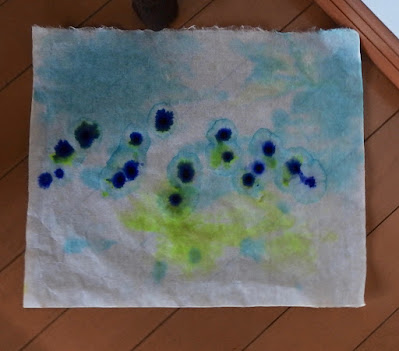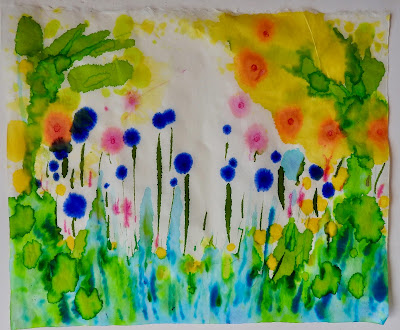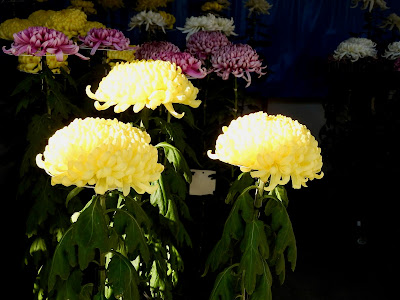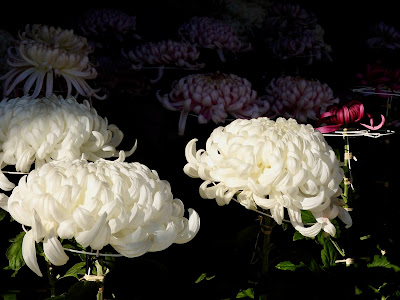目次 / Contents
1) 湯島天神 / Yushima Tenman-gū
A. 雷神から学問の神様 / God of Learning From God of Thunder
B. 社伝 / Shrine Biography
C. 到着 / Arrival
2) 菊まつり / Chrysanthemum Festival
3) 猿回し / Monkey Show
 |
湯島天満宮周辺
湯島天神の近くに不忍池 (シノバズノイケ)があります。
私と夫Rは根津駅から湯島駅へ移動。
Around Yushima Tenman-gū
There is Shinobazu Pond near Yushima Tenmangu.
I and my husband R moved from Nezu station to Yushima station. |
 |
湯しま天神坂上眺望
歌川 広重 (ウタガワ ヒロシゲ / 1797 -1858) 画
夫婦坂 (メオトザカ)からの眺めですが、
現在は高い建物ができて不忍池は見えません。
Hilltop View, Yushima Tenjin Shrine
by Utagawa Hiroshige (1797 -1858)
This is a view from Meotozaka ; Married Couple Hill.
but now the high buildings are built
and Shinobazu Pond cannot be seen.
画像は下記より / This from below
★ |
1) 湯島天神 / Yushima Tenman-gū
A. 雷神から学問の神様
God of Learning From God of Thunder
私は、湯島天神 (ユシマテンジン) と呼びますが、正式には、
日本では、学者が神様になってしまうことをあまり不思議に思いませんが、世界的に見ると、結構珍しいことなのかもしれません。
他の例としては、吉田 松陰 (ヨシダ ショウイン / 1830 - 1859) の 松陰神社訪問については下記。
松陰神社の祭神は吉田松陰でなく、彼の門下生まで祀られています。
話を湯島天神に戻します。
菅原道真は、権力争いの犠牲になり、朝廷の中心から大宰府 (九州) へ左遷されました。
この落雷のために醍醐天皇 (885 - 930) は体調を崩し、3ヶ月後に崩御します。
道真の怨霊が雷神:天神となり、落雷を起こしたと考えられました [清涼殿落雷事件(セイリョウデン ラクライジケン/ 930)]。
多くの災が道真の怨霊のよるものと人々が信じ、彼の霊を治めるため、彼を天満天神とし、祀るようになりました。
これが天神信仰となり、全国各地に天満宮が創設されました。
本来、天神とは国津神 : 地神 (クニツカミ) に対する天津神 (アマツカミ) のことであり特定の神の名ではありませんでしたが上記のような繋がりで、現在では神格となった道真を意味します。
怨霊の記憶が薄れ、世の中が平和になり、道真が優れた学者であったことから天神は「学問の神様」と考えられるようになり、現在に至ります。
道真は、人からへ雷神へ、雷神から学問の神様になったのですね。
本家本元の太宰府天満宮 (ダザイフ テンマングウ) には、2015年に行きました (下記)。
 |
雷神図
尾形 光琳 (オガタ コウリン / 1658 - 1716) 画
Thunder God Figure
By Ogata Kōrin (1658 - 1716)
画像は下記より / This from below
★ |
God of Learning From God of Thunder
It is not so strange that a scholar becomes a god in Japan, but it may be quite unusual in the rest of the world.
For example, another God who was a scholar,
Yoshida Shōin (1830 - 1859) is the deity of
Shōin Shrine, and that Shrine is not only enshrined to him but also some of his students.
About visiting Shōin Shrine, below.
"Yoshida Shōin was one of Japan's most distinguished intellectuals in the late years of the Tokugawa shogunate.
Back to Yushima Tenman-gū,
Michizane was the victim of a power struggle and was relegated from the centre of the imperial court to Dazaifu which is a Japanese term for the regional government in Kyushu from the 8th to the 12th centuries.
After Michizane's death, a series of natural disasters such as thunder, large fires, and plagues occurred in Heian-kyō, and there was a lightning strike that caused multiple deaths at the emperor's residence, 'Seiryoden' in 930.
Due to this lightning strike, Emperor Daigo (885 - 930) became ill and died three months later.
It was thought that Michizane's vengeful spirit became Raijin : Tenjin and caused the lightning strike ["Case of Lightning strike in Seiryoden", 930 ].
People believed that many disasters were due to Michizane's vengeful spirit, and in order to rule his spirit, they was made him Tenjin (a God) and worshiped him.
This became the Tenjin faith, and Tenman-gū shrines were established all over Japan.
Originally, Tenjin are the Gods of Amatsukami : Heaven, as opposed to the Gods of Kunizu: the Gods of the earth (Kunitsukami) who appear in Ashihara no Nakatsukuni : the world between
With the above connection, Tenjin now means Michizane, who is now a divinity.
The memory of Michizane's grudges faded, the world became peaceful, Michizane had been an excellent scholar, so Tenjin came to be considered as a "God of Learning" and continues to this day.
Michizane had become Raijin : God of Thunder from a human and he later became the God of Learning, from Raijin.
We visited Dazaifu Tenman-gū, the origin and the head shrine of Tenman-gū in 2015, below.
B. 社伝 / Shrine Biography
雄略天皇 (ユウリャクテンノウ / 418 - 479 / 在位 : 456 - 479) の勅命により天之手力雄命 (アメノダヂカラヲノミコト) を祀る神社として創建されたとしています。
天之手力雄命は、いくつかの違った名前を持っています。
日本神話では、アマテラス (天照大神 : アマテラス ノ オオカミ) が
怪力を持つというイメージのあるタヂカラオは、力の神、スポーツの神として知られ、全国に彼を祀る神社があり、神楽もあります。
458年の創建に加え、社伝では、1355年、住人 (郷民/ ゴウミン)が菅原道真への祈願を希望し、合わせて祀られることになったとされています。
1590年、徳川 家康 (1543 - 1616) が江戸城に入ってから、徳川家の崇敬を受け、庶民からも親しまれるようになりました。
2000年、湯島神社から湯島天満宮に改称しました。
 |
天岩戸を引き開けるアメノタヂカラオ
月岡芳年 (ツキオカ ヨシトシ / 1839 - 1892) 画
Ame no Tajikarao opening the Amano-Iwato 画像は下記より / This from below
★ |
Shrine Biography
Ame no Tajikarao has several different names.
In order to get Amaterasu out of the cave the other Gods, known as
Amaterasu looked out from the Rock door : Iwato, then
Ame no Tajikarao took her hand and pulled her out.
Ame no Tajikarao, who has the image of having superhuman strength, is known as the God of power and the God of sports.
There are shrines enshrining him all over the country, and there are also Kaguras which are specific types of Shinto ritual ceremonial dance.
In addition to its founding in 458, the Shrine's biography states that in 1355, residents wished to pray for Sugawara no Michizane and were enshrined together.
After Tokugawa Ieyasu (1543 - 1616) entered Edo Castle in 1590, the shrine was revered by the Tokugawa family and became popular for people.
In 2000, the name was changed from Yushima Shrine to Yushima Tenman-gū.
 |
Map
(Only in Japanese)
画像は下記より / This from below
★
|
C. 到着 / Arrival
 |
夫婦坂
夫婦坂(メオトザカ)を登って、湯島天神へ入りました。
この時は、ここが夫婦坂と呼ばれていることを知りませんでした。
他の坂は、女坂、男坂と呼ばれています。
Meoto-zaka ; Married Couple Hill
We climbed Meoto-zaka and entered Yushima Tenman-gū.
At that time, I didn't know that this approach is called Meoto-zaka.
The other hills are called Onnazaka ; Woman Hill
and Otokozaka ; Man Hill.

裏門 ・登竜門
'登竜門' (トリュウモン)...坂の名前とは、
随分雰囲気が違う名前です。
学業成就 (ガクギョウジョウジュ) からの関連の
登龍門 (トリュウモン) でしょうか?
ですが、裏門に登竜門というのは
ちょっと疑問に思うネーミングです。
裏口入学を連想させます。
そう感じるのは私だけでしょうか?
Back Gate ・ Toryumon ; Dragon Climbing Gate
'Toryumon'... is a name with a very different atmosphere
to the hill name : Meoto-zaka : Married Couple Hill.
Is the back gate name : 登竜門 (Toryumon),
related to Toryumon (登龍門) which is
a first step (gateway) to succes of academic achievement?
However, giving the back gate the name
"Toryumon" is a little strange.
It is reminiscent of backdoor admission.
Am I the only one who feels that way?
門には竜のレリーフがあります。
写真がボケててすみません。
There are dragon reliefs on the gate.
I'm sorry that the photograph is out of focus.
|
英国留学前に、私がここへきたのは、落語会があったからでした。
うろ覚えですが、参集殿2階の畳の部屋であったと思います。
当時、落語が好きで、落語会や講談の会にへ結構、出かけていました。
落語は好きでしたが、寄席にはあまり行っていなかったと思います。
湯島天神の落語会へは一度きりだったと思います。
 |
本殿の横
現在の建造物は1995年に、
ヒノキのみを使用して作られ、神社建築の伝統に従って
再建されました。
本殿正面からの撮影を忘れました。
Side of Main Building
The current building was built in 1995 using only cypress timber
and was rebuilt using traditional shrine carpentry.
I forgot to photograph from the front of the main shrine.
 |
 |
本殿 / Main Building
画像は下記より / This from below
★
|
Before studying in Britain, I came here because there was a
Rakugo event.
Rakugo is a form of Japanese
verbal entertainment.
As I remember, I think it was in a tatami room on the first floor in Sanshu-den : the Gathering Hall.
At that time, I liked Rakugo, so I went to Rakugo events and to
Kōdan which is a style of traditional oral Japanese storytelling.
I liked Rakugo, but I think I didn't go to Yose Theatre : the vaudeville.
I think I only went once for Yushima Tenman's Rakugo event.
 |
表鳥居 / Main Gate : Omote Torii
 |
"この鳥居は銅製で、寛文7年(1667)同8年の刻銘があり、この時期に寄進された物です。
数度の修理を重ねて維持されてきましたが、都内に遺存する鋳造の鳥居としては時代も古く、製作も優秀なもので、昭和45年8月に東京都指定有形文化財に指定されました。
鳥居の様式は神明鳥居といわれるもので、横木が二重になり、反りをもって、柱が内側に傾いています。 横木の上の方を笠木、下の方を島木といいます。"
According to the Shrine's Website, (Translated by me)
"This Torii (gate) is made of copper and has an inscription made in the 7th year of Kanbun (1667), and was donated during this period.
Though it has been repaired and maintained several times, it is very high quality and the oldest cast Torii that remains in Tokyo, in August 1970 it was designated as a Tokyo Tangible Cultural Property.
The style of the Torii is called Shinmei Torii, the crossbars are doubled and the pillars are tilted inwards.
The upper crossbar is called Kasagi, and the lower part is called Shimaki."
 |
境内
背景にビルがなかったら、
江戸時代かと思ってしまいますね。
Precincts
If there was no building in the background,
here would be like the Edo period. |
2) 菊まつり / Chrysanthemum Festival
 |
初日 ラッキーでした。
菊約2千株が展示が展示されてたそうです。
この日が初日だったと後になって知りました。 そういえば、まだ空いているスペースがいくつかありました。
First Day Lucky us! About 2,000 chrysanthemums were on display.
Later I found out that this was the first day. Oh! Yes! there were still some empty spaces. |
文京菊まつりは、1979年度から湯島天満宮で行われます。
Bunkyo Chrysanthemum Festival has been held in Yushima Tenman-gū Shrine since 1979.
 |
管物 (カンモノ)
Kanmono ; Pipe Blossom
|
 |
厚物 ( アツシモノ)
Atsushimono : Thick Blossom |
 |
千輪咲 (センリンザキ)
Senrinnzaki ; One Thousand Blossoms
|
管物 / Kanmono
厚物 / Atsushimono
通常では見ることがない、立派な菊がたくさんありました。
育てている方々の苦労も感じました。
美しい花々をありがとうございました。
There were many fine chrysanthemums that I wouldn't normally see.
I also felt the efforts of the people raising them.
Thank you for the beautiful flowers.
3) 猿回し / Monkey Show
 |
猿回し
神社を去ろうとしたら、猿回しが始まりました。
私は実物を初めてみました。
Rも当然、初めてです。
この写真だけ撮影して、湯島天神を後にしました。
Monkey Show
When we were about to leave the shrine, the monkey show began. I saw the real thing for the first time. Of course, for R this was also the first time. I only took this photograph and we left Yushima Tenjin. |


















































